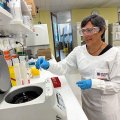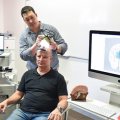The University of Queensland will partner with CSIRO and a number of world-leading organisations in a new solar research program, with the aim of bringing cheaper, cleaner power to the world.
Six Australian universities, the United States’ Department of Energy’s National Renewable Energy Laboratory (NREL), Sandia National Laboratories and Arizona State University will collaborate under CSIRO’s leadership.
The Australian Government said the eight-year, $87 million Australian Solar Thermal Research Initiative (ASTRI) aimed to lower the cost of solar thermal power from 25 to around 10 cents a kilowatt hour.
CSIRO’s other university partners for the solar thermal research initiative include Australian National University, The University of Adelaide, The University of South Australia, Queensland University of Technology and Flinders University.
UQ’s Deputy Vice-Chancellor (Research), Professor Max Lu, said that through the collaborative efforts of world-leading researchers such as those in this initiative, renewable energy technology was fast advancing.
“In coming decades we will see dramatic changes in the way the world generates and distributes power, and the world will be a cleaner place with lower carbon emissions,” he said.
Collaboration between government and key universities and companies was the most productive way forward in research and innovation to advance solar energy, Professor Lu said.
“Our Vice-Chancellor Professor Peter Høj has a great vision for UQ, to enhance engagement and partnership with industry, government, and community,” he said. “This is a great example of such partnership.”
Professor Lu said UQ’s involvement in the ASTRI collaboration was a tribute to the significant energy research capacity and expertise the University had built in recent years.
UQ’s St Lucia, Brisbane, campus is home to Australia’s largest rooftop photovoltaic array, a 1.22 megawatt installation across four buildings that supplies about five per cent of the University’s peak power demand and is a key piece of research infrastructure.
CSIRO’s Energy Transformed Flagship Director, Dr Alex Wonhas, said the Australian Solar Institute and Australian Renewable Energy Agency’s $35 million contribution made ASTRI possible and ensured Australia remained at the leading edge of global solar research.
The funding provided CSIRO with the opportunity to work with the world’s best and fully develop solar thermal technology.
“A world-class collaboration of this scale ensures we are well on our way to lower the cost of solar thermal technology,” Dr Wonhas said.
“Demonstrating the technology is vital; it is what attracts investment and development in the industry.”
Solar thermal power uses mirrors to concentrate sunshine to generate heat, which then powers a turbine to create electricity or solar derived fuel. CSIRO’s solar thermal tower at Newcastle is an example of the technology.
Media: Jan King, UQ Communications, ph 0413 601 248; Fiona Cameron, UQ Communications, ph +61 7 3346 7086; Kirsten Lea, kirsten.lea@csiro.au, +61 2 4960 6245 / 0457 563 684
.jpg)












